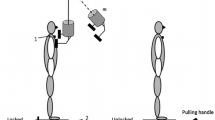Abstract
Postactivation effects consisting of protracted involuntary muscular contraction after 30–60 sec sustained voluntary effort were investigated. It was found that postactivation effects may be observed at the proximal muscles (uninvolved in the voluntary activity) following distal muscle contraction. Testing the state of muscles by the vibration activity of the muscle receptors showed that concealed changes persisting for 15–20 min occur apart from the direct postactivation effects already known. The point is made that postactivation phenomena reflecting the operation of certain central tonogenic structures activated by a voluntary effort or an increased afferent inflow may successfully be used in the study of postural control mechanisms.
Similar content being viewed by others
Literature cited
V. G. Kunevich, "Ukhtomskii's tonic response," LGU. Biological Sciences Series. Physiology and Biochemistry,164, 251–261 (1954).
R. Magnus, Apparatus of the Body [in Russian], Akad. Nauk. SSSR, Moscow; Leningrad (1962).
A. A. Ukhtomskii, "A special type of tonic response in the human limbs," Collected Works, Leningrad (1962).
B. Craske and J. D. Craske, "Oscillator mechanisms in the human motor system: investigating their properties using the aftercontraction effect," J. Mot. Behav.,18, No. 2, 117–145 (1986).
J. Hounsgaard, H. Hultborn, B. Jespersen, and O. Keiehn, "Intrinsic membrane properties causing a bistable behaviour of α-motoneurones," Exp. Brain Res.,55, No. 2, 391–394 (1984).
H. Hultborn, H. Wigstrom, and B. Wangberg, "Prolonged activation of soleus motoneurones following a conditioning train in soleus Ia afferents — a case for reverberating loop?" Neurosci. Lett.,1, 147–152 (1975).
R. S. Hutton, K. Kaiya, S. Suzuki, and S. Watanabe, "Post-contraction errors in human force production are reduced by muscle strength," J. Physiol.,393, No. 1, 247–259 (1987).
O. Kohnstamm, "Demonstration einer katatonieartigen Erscheinung beim Gesungen (Katatonieartigen Erscheinung beim Gesungen (Katatonusversuch)," Neurol. Zbl.,34, 290–291 (1915).
R. Matthaei, "Nachbewegungen beim Menschen (Untersuchungen über das Sog. Kohnstammsche Phänomen)," Pflüg. Arch.,202, No. 1/2, 88–111 (1924).
D. I. McCloskey, "Kinesthetic sensibility," Physiol. Rev.,58, No. 4, 763–820 (1978).
S. Mori, H. Nishimura, and M. Aoki, "Brain stem activation of the spinal stepping generator," in: The Reticular Formation Revisited, Raven Press, New York (1980).
M. Rothman, "Zum Katatonusversuch (Kohnstamm)," Neurol. Zbl.,34, 421–425 (1915).
Additional information
Institute for Research into Information Transmission, Academy of Sciences of the USSR, Moscow. Translated from Neirofiziologiya, Vol. 21, No. 3, pp. 343–351, May–June, 1989.
Rights and permissions
About this article
Cite this article
Gurfinkel', V.S., Levik, Y.S. & Lebedev, M.A. Immediate and remote postactivation effects in the human motor system. Neurophysiology 21, 247–253 (1989). https://doi.org/10.1007/BF01058224
Received:
Issue Date:
DOI: https://doi.org/10.1007/BF01058224




